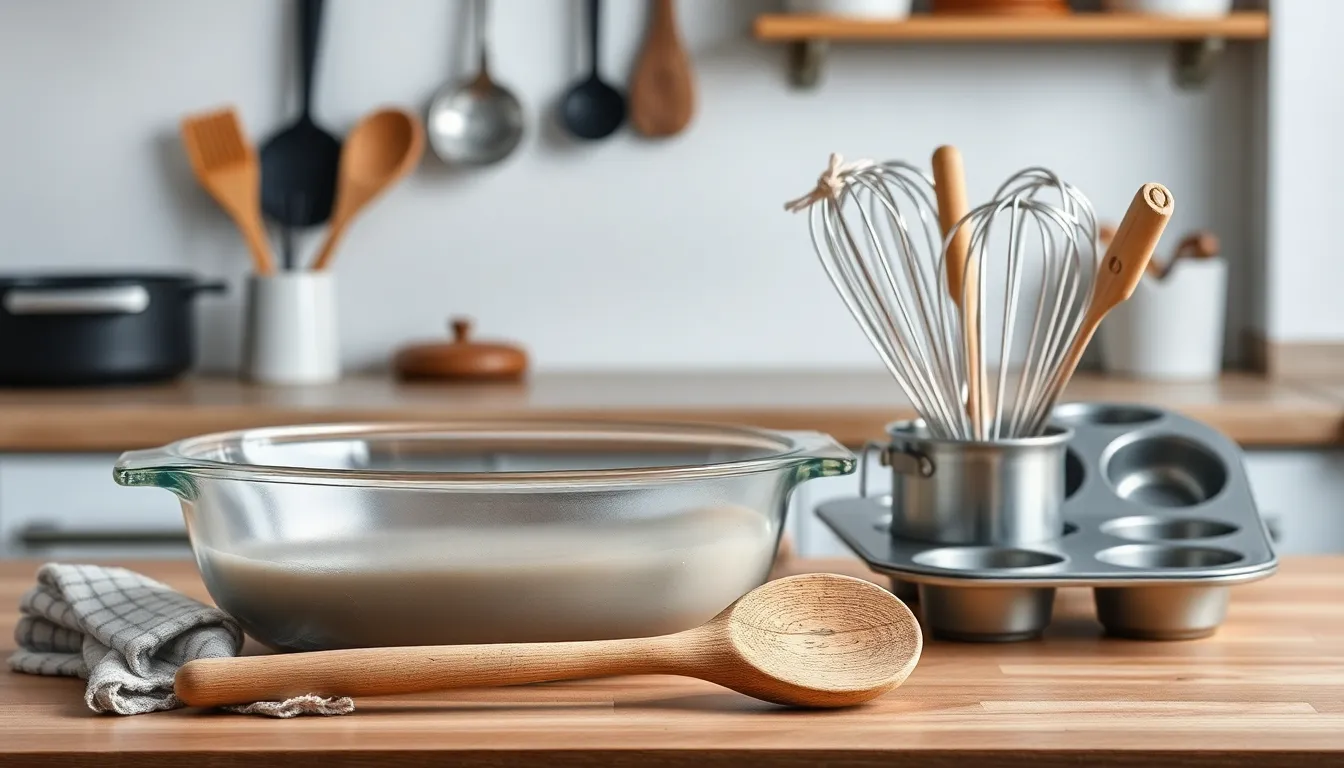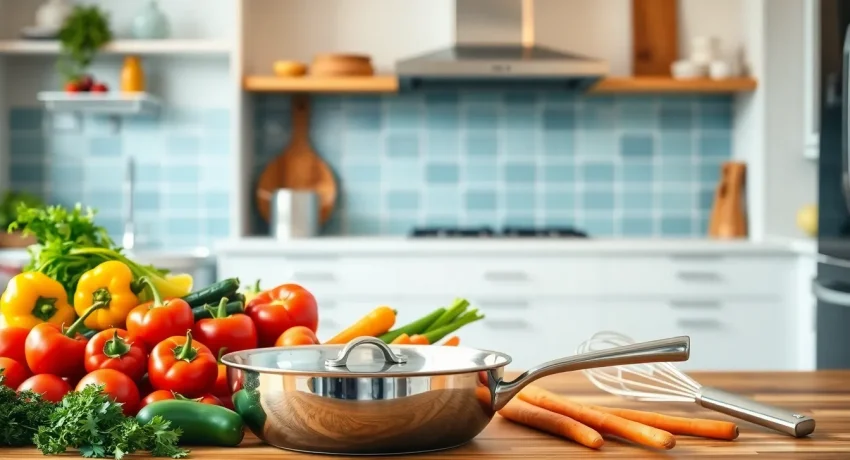In the bustling world of cooking, knowing your kitchen vocabulary can be the secret ingredient to culinary success. Whether you’re a seasoned chef or a novice whipping up instant ramen, mastering the lingo can elevate your kitchen game. Imagine impressing your friends by casually tossing around terms like “julienne” and “sauté” while they struggle to figure out how to boil water.
But don’t worry if you feel lost in a sea of spatulas and soufflés. This guide will break down essential kitchen vocabulary, ensuring you’ll sound like a pro in no time. So grab your apron, sharpen those knives, and get ready to transform your kitchen chatter from “uh-oh” to “voilà!” With a sprinkle of humor and a dash of knowledge, you’ll soon be cooking up a storm and chatting like a culinary connoisseur.
Table of Contents
ToggleOverview of Kitchen Vocabulary
Mastering kitchen terminology aids in enhancing culinary skills. Terms like “dice,” “braise,” and “whisk” form the foundation of effective cooking. Familiarity with these words allows cooks to follow recipes and understand techniques.
Culinary verbs describe actions taken during food preparation. “Grill” refers to cooking food over an open flame, while “poach” means gently simmering food in water or broth. Understanding these distinctions ensures precision in the kitchen.
Descriptive adjectives also play a role. “Ripe” indicates fruit at its peak freshness, while “al dente” describes pasta that retains a firm texture when bitten. Such terms help in achieving desirable results.
Kitchen equipment has its own vocabulary as well. Items such as “colander,” “mandoline,” and “sauté pan” facilitate various culinary tasks. Knowing these tools enables efficient preparation and utilization of ingredients.
Safety vocabulary is crucial as well. “Mise en place,” a French term meaning “everything in its place,” emphasizes organization and safety in cooking. “Cross-contamination” refers to the transfer of harmful bacteria, highlighting the importance of food safety.
Understanding measurements contributes significantly to replicating recipes. “Teaspoon,” “tablespoon,” and “cup” serve as primary units for accuracy. This familiarity promotes consistency in cooking.
Overall, mastering kitchen vocabulary enriches cooking experiences. By knowing these terms, cooks can communicate skills effectively, follow recipes accurately, and create delicious dishes with confidence.
Essential Kitchen Tools

Familiarity with essential kitchen tools elevates the cooking experience. Mastery over these instruments promotes efficiency and precision in meal preparation.
Cooking Utensils
Spoons, spatulas, and whisks serve as foundational cooking utensils. Each utensil fulfills specific roles, ensuring tasks like mixing, flipping, and serving get done seamlessly. Tongs are excellent for turning foods on the grill or in the pan, providing a secure grip. Ladles assist with serving soups and sauces, preventing spills. A sturdy wooden spoon stands out for its durability, making it ideal for stirring thick mixtures.
Bakeware Essentials
Baking pans, cookie sheets, and muffin tins form the core of bakeware essentials. Each piece plays a crucial role in achieving desired textures and shapes. A glass baking dish is perfect for casseroles, allowing even cooking. Silicone mats enhance baking by preventing sticking and promoting even heat distribution. Muffin tins ensure that batter rises uniformly, creating perfectly shaped muffins. Pyrex measuring cups offer precision in ingredient measurement, crucial for successful baking outcomes.
Common Kitchen Ingredients
Familiarity with common kitchen ingredients simplifies cooking. These ingredients play an essential role in achieving flavor and texture in dishes.
Spices and Herbs
Spices and herbs add character to meals. Basil, a fragrant herb, enhances Italian dishes. Oregano, often paired with basil, complements Mediterranean flavors. Cumin provides a warm, earthy taste, frequently found in curry and chili recipes. Paprika, with its distinct color, adds mild heat and visual appeal to various dishes. Understanding how to use these ingredients leads to a more flavorful outcome in cooking.
Fresh Produce
Fresh produce forms the backbone of many recipes. Tomatoes, enjoyed raw or cooked, provide acidity and sweetness. Bell peppers, available in various colors, add crunch and a hint of sweetness. Carrots, packed with vitamins, enhance both flavor and nutrition. Incorporating fresh herbs, like cilantro and parsley, brightens up flavors and adds freshness. Utilizing seasonal produce yields the best taste and quality in dishes.
Cooking Techniques and Terminology
Cooking techniques expand the repertoire of any cook, whether a novice or a veteran. Familiarity with methods like baking and frying enhances meal preparation.
Baking vs. Frying
Baking employs dry heat in an oven, creating even temperatures for consistent cooking. This method suits dishes like bread, cakes, and casseroles, resulting in textures that range from fluffy to crispy. Frying, on the other hand, uses hot oil or fat to cook food quickly, imparting a distinct flavor and crispiness to items like chicken and potatoes. While frying can add richness, it increases fat content, necessitating balanced recipe choices. Both methods contribute unique qualities, allowing cooks to pick the right technique for desired outcomes.
Sautéing and Steaming
Sautéing involves cooking food quickly in a small amount of oil over high heat. This technique creates caramelization, lending depth to vegetables and proteins. It focuses on flavor development, making it ideal for stir-fries and quick sautés. Steaming uses water vapor to cook food gently, preserving nutrients and color. This method suits delicate items like fish and vegetables, maintaining texture while enhancing healthfulness. By understanding these methods, cooks can choose optimal techniques for enhancing dishes effectively.
Mastering kitchen vocabulary is a vital step toward culinary confidence and success. With a solid grasp of essential terms and tools, anyone can elevate their cooking skills and transform their kitchen experience. Embracing this knowledge not only enhances communication but also fosters creativity in meal preparation.
By understanding the nuances of cooking techniques and ingredients, cooks can make informed decisions that lead to delicious outcomes. Whether preparing a simple dish or an elaborate feast, having the right vocabulary at one’s disposal makes all the difference. As they continue to explore the culinary world, readers will find that this foundational knowledge unlocks endless possibilities in their kitchen adventures.




